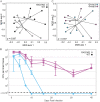The Gut Microbiota Is Associated with Clearance of Clostridium difficile Infection Independent of Adaptive Immunity
- PMID: 30700514
- PMCID: PMC6354811
- DOI: 10.1128/mSphereDirect.00698-18
The Gut Microbiota Is Associated with Clearance of Clostridium difficile Infection Independent of Adaptive Immunity
Abstract
Clostridium (Clostridioides) difficile, a Gram-positive, anaerobic bacterium, is the leading single cause of nosocomial infections in the United States. A major risk factor for Clostridium difficile infection (CDI) is prior exposure to antibiotics, as they increase susceptibility to CDI by altering the membership of the microbial community enabling colonization. The importance of the gut microbiota in providing protection from CDI is underscored by the reported 80 to 90% success rate of fecal microbial transplants in treating recurrent infections. Adaptive immunity, specifically humoral immunity, is also sufficient to protect from both acute and recurrent CDI. However, the role of the adaptive immune system in mediating clearance of C. difficile has yet to be resolved. Using murine models of CDI, we found that adaptive immunity is dispensable for clearance of C. difficile However, random forest analysis using only two members of the resident bacterial community correctly identified animals that would go on to clear the infection with 66.7% accuracy. These findings indicate that the indigenous gut microbiota independent of adaptive immunity facilitates clearance of C. difficile from the murine gastrointestinal tract.IMPORTANCEClostridium difficile infection is a major cause of morbidity and mortality in hospitalized patients in the United States. Currently, the role of the adaptive immune response in modulating levels of C. difficile colonization is unresolved. This work suggests that the indigenous gut microbiota is a main factor that promotes clearance of C. difficile from the GI tract. Our results show that clearance of C. difficile can occur without contributions from the adaptive immune response. This study also has implications for the design of preclinical studies testing the efficacy of vaccines on clearance of bacterial pathogens, as inherent differences in the baseline community structure of animals may bias findings.
Keywords: Clostridium difficile; adaptive immunity; colonization resistance; intestinal colonization; microbiota.
Copyright © 2019 Leslie et al.
Figures





Similar articles
-
Diluted Fecal Community Transplant Restores Clostridioides difficile Colonization Resistance to Antibiotic-Perturbed Murine Communities.mBio. 2022 Aug 30;13(4):e0136422. doi: 10.1128/mbio.01364-22. Epub 2022 Aug 1. mBio. 2022. PMID: 35913161 Free PMC article.
-
Clostridium difficile Alters the Structure and Metabolism of Distinct Cecal Microbiomes during Initial Infection To Promote Sustained Colonization.mSphere. 2018 Jun 27;3(3):e00261-18. doi: 10.1128/mSphere.00261-18. Print 2018 Jun 27. mSphere. 2018. PMID: 29950381 Free PMC article.
-
Clearance of Clostridioides difficile Colonization Is Associated with Antibiotic-Specific Bacterial Changes.mSphere. 2021 May 5;6(3):e01238-20. doi: 10.1128/mSphere.01238-20. mSphere. 2021. PMID: 33952668 Free PMC article.
-
Role of microbiota and innate immunity in recurrent Clostridium difficile infection.J Immunol Res. 2014;2014:462740. doi: 10.1155/2014/462740. Epub 2014 Jun 5. J Immunol Res. 2014. PMID: 24995345 Free PMC article. Review.
-
Interactions Between the Gastrointestinal Microbiome and Clostridium difficile.Annu Rev Microbiol. 2015;69:445-61. doi: 10.1146/annurev-micro-091014-104115. Annu Rev Microbiol. 2015. PMID: 26488281 Free PMC article. Review.
Cited by
-
Computational modeling of the gut microbiota reveals putative metabolic mechanisms of recurrent Clostridioides difficile infection.PLoS Comput Biol. 2021 Feb 22;17(2):e1008782. doi: 10.1371/journal.pcbi.1008782. eCollection 2021 Feb. PLoS Comput Biol. 2021. PMID: 33617526 Free PMC article.
-
Portulaca Oleracea L. as a Potential Therapeutic Drug Intervention in Ulcerative Colitis: Mechanisms of Action and Clinical Studies.Drug Des Devel Ther. 2024 Dec 11;18:5931-5946. doi: 10.2147/DDDT.S486407. eCollection 2024. Drug Des Devel Ther. 2024. PMID: 39679131 Free PMC article. Review.
-
Capturing the environment of the Clostridioides difficile infection cycle.Nat Rev Gastroenterol Hepatol. 2022 Aug;19(8):508-520. doi: 10.1038/s41575-022-00610-0. Epub 2022 Apr 25. Nat Rev Gastroenterol Hepatol. 2022. PMID: 35468953 Review.
-
Type 3 Immunity during Clostridioides difficile Infection: Too Much of a Good Thing?Infect Immun. 2019 Dec 17;88(1):e00306-19. doi: 10.1128/IAI.00306-19. Print 2019 Dec 17. Infect Immun. 2019. PMID: 31570564 Free PMC article. Review.
-
Diluted Fecal Community Transplant Restores Clostridioides difficile Colonization Resistance to Antibiotic-Perturbed Murine Communities.mBio. 2022 Aug 30;13(4):e0136422. doi: 10.1128/mbio.01364-22. Epub 2022 Aug 1. mBio. 2022. PMID: 35913161 Free PMC article.
References
-
- Lessa FC, Mu Y, Bamberg WM, Beldavs ZG, Dumyati GK, Dunn JR, Farley MM, Holzbauer SM, Meek JI, Phipps EC, Wilson LE, Winston LG, Cohen JA, Limbago BM, Fridkin SK, Gerding DN, McDonald LC. 2015. Burden of Clostridium difficile infection in the United States. N Engl J Med 372:825–834. doi:10.1056/NEJMoa1408913. - DOI - PMC - PubMed
Publication types
MeSH terms
Grants and funding
LinkOut - more resources
Full Text Sources
Molecular Biology Databases

